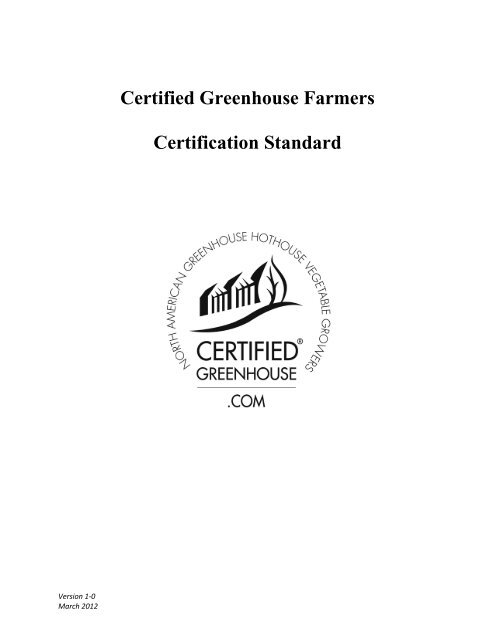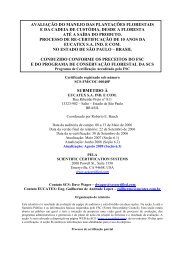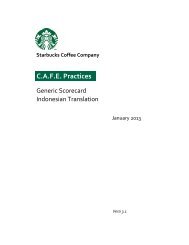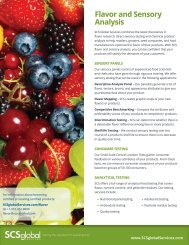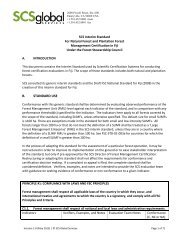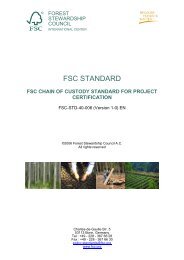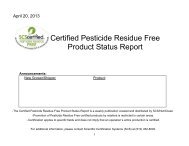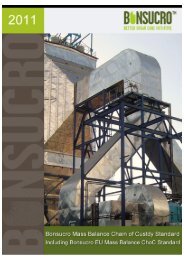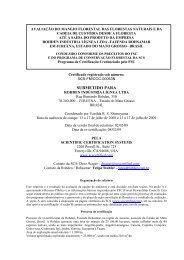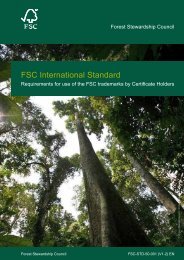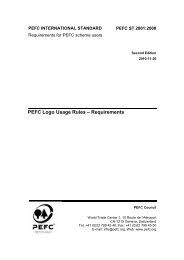Certified Greenhouse Farmers Certification Standard - SCS Global ...
Certified Greenhouse Farmers Certification Standard - SCS Global ...
Certified Greenhouse Farmers Certification Standard - SCS Global ...
Create successful ePaper yourself
Turn your PDF publications into a flip-book with our unique Google optimized e-Paper software.
<strong>Certified</strong> <strong>Greenhouse</strong> <strong>Farmers</strong><strong>Certification</strong> <strong>Standard</strong>Version 1‐0March 2012
1.0 Purpose, Structure and Intended Uses1.1. PurposeThe purpose of the <strong>Standard</strong> is to establish a common set of requirements for infrastructure andagricultural production practices in greenhouses which have achieved certification in food safetyand have demonstrated investments in advanced technologies. The ecological requirementsensure that an agricultural product has been produced in a distinctly environmentally soundmanner. In addition, the <strong>Standard</strong> is intended to establish guidelines for best managementpractices that will allow growers a mechanism for internal benchmarking with sustainabilitypractices.The <strong>Standard</strong> is in support of the definition of greenhouse grown vegetables as set forth by the<strong>Certified</strong> <strong>Greenhouse</strong> <strong>Farmers</strong> (CGF):A fully enclosed permanent aluminum or steel structure clad eitherin glass or impermeable plastic for the controlled environmentalgrowing of certified greenhouse/hothouse vegetables usingtogether computerized irrigation and climate control systems,including heating and ventilation capability; grown in a soillessmedium that substitutes for soil (under the greenhouse/hothouse);using hydroponic methods; Integrated Pest Management andwithout the use of herbicides.1.2. Structure of the <strong>Standard</strong>The framework set forth in this <strong>Standard</strong> addresses a spectrum of issues – prerequisites,greenhouse design and optional ecosystem management and integrated waste managementprotection – summarized under the following elements:Prerequisites - Application with CGF- Audited by Recognized GFSI Third-Party FoodSafety Program- <strong>Greenhouse</strong> Production Plan<strong>Greenhouse</strong> Design andOperation AuditOptional: EcosystemManagement and ProtectionOptional: Integrated WasteManagement- <strong>Greenhouse</strong> Structure and EnvironmentalControls- Water Management- Integrated Pest Management- Plant Nutrition Management- Site Erosion Control- Habitat Management and Protection- Packaging Resource Minimization- Management of Product and Other Wastes- Management of Hazardous MaterialsThe <strong>Standard</strong> contains prerequisite requirements and certification requirements (Tier 1), as wellas optional best management practices (Tier 2) for future consideration or implementation.Version 1‐0March 2012 Page 1
1.3. Intended UsersIntended users of this <strong>Standard</strong> are: 1) agricultural producers; 2) purchasers of agriculturalproducts, including consumers, businesses, institutions, government agencies, and other entities.1.4. Voluntary <strong>Standard</strong>This <strong>Standard</strong> is voluntary to support the certification of CGF membership. It is not intended toreplace the legal or regulatory requirements of any country in which agricultural products areproduced.1.5. Role of <strong>SCS</strong> as a <strong>Certification</strong> BodyThis <strong>Standard</strong> is owned by CGF. The role of <strong>SCS</strong> is to audit prospective and existing membersof the organization to a checklist that has been developed by <strong>SCS</strong> and is the property of thecertification body. The audit serves to validate a member meeting the standards set forth formembership. <strong>Certification</strong> of a producer to meet these requirements is the responsibility of <strong>SCS</strong>.A producer may appeal 1 the results of the audit to <strong>SCS</strong>, at which time <strong>SCS</strong> will appoint aCommittee to review the complaint. The decisions of <strong>SCS</strong> are final.1 See <strong>SCS</strong> Corporate Complaint, Appeal and Dispute Investigation Procedure(http://www.scscertified.com/docs/<strong>SCS</strong>_PRO05_ComplaintsAppealsDisputes_V3-1_061209.pdf)Version 1‐0March 2012 Page 2
2.0 Goals2.1. GoalsThe major goals of this <strong>Standard</strong> are:To establish core requirements for certification that separate greenhouse growersfrom growers of field and/or protected culture crops;To provide for clear distinction between certified growers and non-certified growersthrough detailed requirements that range from prior certifications as a prerequisite toadvanced design and operational considerations in order to secure safe food andprotect the environment;To encourage a growing segment of the vegetable production sector to implementbetter practices in terms of structure and operational procedures;To validate production practices as meeting the requirements of CGF, therebyallowing members to use the organization’s trademark, logo, or other messaging ontheir product, packaging, website, or other approved marketing practices.Version 1‐0March 2012 Page 3
3.0 Conformance3.1. Conformance RequirementsThis <strong>Standard</strong> establishes prerequisite requirements for all greenhouse vegetable producers, andprovides two tiers of potential conformity upon which claims may be made. Tier 1 establishesthe baseline performance for certified greenhouse production practices, while Tier 2 representsan even higher level of performance involving state-of-the-art or best management practices. Inaddition, Producers may request that optional sustainability criteria be subject to audit review.Tier 1 and Tier 2 requirements and optional sustainability criteria are described in Sections 4-7of this <strong>Standard</strong>.Critical RequirementsFor conformance to the <strong>Standard</strong>Optional Sustainability Criteria4.3.1. 4.3.54.3.2. 4.3.6.4.3.3. 6.1.1.1.4.3.4. 6.1.2.1.5.1.1.1. 6.2.1.1.5.2.1.1. 6.2.1.2.5.2.1.2. 6.2.1.3.5.2.1.3. 7.1.1.1.5.3.1.1.1. 7.2.1.1.5.3.1.1.2. 7.2.1.2.5.4.1.1. 7.2.1.3.5.4.1.2. 7.2.1.4.5.4.1.3. 7.3.1.1.7.3.1.3.In order to be considered conformant to Tier 1 of this <strong>Standard</strong>, a Producer must conform withall “critical requirements” and must conform with at least 90% of the Tier 1 requirements(prerequisite, critical, and non-critical) in Sections 1 - 5 of the <strong>Standard</strong>.For Sustainability recognition, a producer must conform with all "critical requirements" andconform to 90% of the Tier 1 requirements in Sections 4-7 of the <strong>Standard</strong>, and for SustainablyExcellence, conform with 80% or more of the Tier 2 requirements.3.2. Scope of ConformanceConformance may be established solely for a <strong>Greenhouse</strong> Production Operation. For example,products that are grown in one geographic location on the farm or in some ranges/greenhousemay be in conformance, while the same product grown in another location may not be inconformance. <strong>Greenhouse</strong>s Production Operations must have distinct, defined boundaries thatare accurately registered in the specific CGF Program documents.Version 1‐0March 2012 Page 4
3.3. Demonstrating Conformance for Public ClaimsProducers of vegetable products seeking to make public claims based on this <strong>Standard</strong> aregoverned by CGF. Public claims are not permitted unless compliance has been demonstratedthrough the successful passing of a CGF <strong>Certification</strong> <strong>Standard</strong> audit.Version 1‐0March 2012 Page 5
4.0 Element 1: Prerequisite RequirementsThis section of the <strong>Standard</strong> describes general conformance requirements for all greenhousevegetable producers. The Producer is required to develop and implement written managementplans to support the certification objectives outlined in this <strong>Standard</strong>.4.1. Affiliation with the <strong>Certified</strong> <strong>Greenhouse</strong> <strong>Farmers</strong>4.1.1. Proof of AffiliationThe Producer shall demonstrate proof of application for membership to CGF.4.2. Compliance with Food Safety <strong>Standard</strong>s4.2.1. GAP/GMP AuditsThe Producer shall demonstrate that its facilities involved in the production of theagricultural product have undergone a third-party GFSI audit during the previous 12months in accordance with the relevant U.S. Good Agricultural Practice or GoodManufacturing Practice guidance, or in accordance with more stringent voluntary industryor mandated government requirements. The Producer shall provide evidence ofcompliance with any required corrective actions that are the result of Immediate Risk orMajor Must determinations. Validation of the corrective action shall be subject to reviewby <strong>SCS</strong>.4.2.2. Food Pathogen Prevention ProceduresThe Producer shall maintain written response procedures in the event that a food pathogenis detected at any point during the chain of custody, including, but not limited to: productquarantine, product recall, client notification, confirmation testing, contaminant sourceinvestigation, and corrective action steps.4.2.3. Conformance with U.S. or Canadian Food Safety GuidanceThe Producer shall demonstrate that agricultural products have been produced inaccordance with U.S. Food and Drug Administration or CGC FSIP-STAN sector-specificguidance principles [Normative References 2 or Additional References 3].4.3. <strong>Greenhouse</strong> Production PlanThe Producer shall establish and maintain a written <strong>Greenhouse</strong> Production Plan 2 , to be updatedand reviewed annually, which describes its agricultural production operations as a means ofensuring that the product conforms to the requirements of this <strong>Standard</strong>. The Plan shall provide,at a minimum, descriptions of:2 The <strong>Certification</strong> Body will provide the Producer with a form that can be filled in and updated to satisfy thisrequirement. <strong>Greenhouse</strong>s and hothouses are both included under the <strong>Greenhouse</strong> Production Plan.Version 1‐0March 2012 Page 6
4.3.1. Crop and Farm Informationa. Vegetable types and varieties in production, including any information regardingdisease/pest sensitivity and resistance/tolerance, as well as identification of designatedagricultural input materials purchased off-farm.b. Ranges, farm parcels, or greenhouses currently in production or intended forcertification, including detailed site maps that place these operations in the context oflandscape features, watersheds, natural habitats, and wildlife, and describe adjacentland uses.4.3.2. Production Techniques and Panting MediaThe production process shall be documented, including pre-harvest and post-harvestoperations.4.3.3. Pest/Disease ManagementA listing and description of integrated pest/disease management practices and the annualamounts of materials in use, including but not limited to mechanical controls, culturalcontrols, biological controls, registered synthetic and botanically-derived pesticides,pesticide rotation strategy, monitoring practices and action thresholds, and weed controlpractices as an alternative to synthetically derived herbicides.4.3.4. Plant Nutrition ManagementA description of the hydroponic methods used for fertility assessments and management. Alisting and description of fertilizer regime, including but not limited to: type, applicationrates, annual amounts used, technologies and quality monitoring (e.g. EC, pH).4.3.5. Ecosystem Management (optional)A description of the effects that the <strong>Greenhouse</strong> Production Operation has had on the site’secology, including erosion, flora and fauna species and habitats, and any mitigation effortsundertaken to date; a description of existing and planned vegetated buffer zones forwatercourses and between ranges and other areas under cultivation and non-cultivatedareas; a list and accompanying maps of any areas of High Ecological Value (HEV),previously identified threatened or endangered habitats or species that are present withinthe property boundaries and, if known, adjacent to this property, including all facilities andfields, cultivated and uncultivated.4.3.6. Integrated Waste Management (optional)Annual documentation of packaging resources used in product packaging and shipping, andthe Producers efforts to minimize waste to landfills. Responsible management practices ofhazardous materials and non-toxic materials are required along with the development of acomprehensive safety plan.Version 1‐0March 2012 Page 7
5.0 Element 2: <strong>Greenhouse</strong> Design and OperationThis section of the <strong>Standard</strong> addresses structure and operational procedures and practicesemployed by the Producer in a greenhouse to manage pests and diseases and provide foressential resources for vegetable production:<strong>Greenhouse</strong> Structure and Environmental ControlsThe Producer is required to document that its vegetable production systems have bothstructural and functional aspects to qualify as a certified greenhouse/hothouse grower.Water ManagementThe Producer is required to conserve water through the use of effective water deliverysystems, conservation and monitoring methods and technologies, and the institutionof water quality management practices to protect the quality of the product and localwater resources.Integrated Pest ManagementThe Producer is required to document its integrated pest and disease managementsystems, including pest/disease monitoring.Plant Nutrition ManagementThe Producer is required to use a synthetic planting media without soils and anutritional delivery system with computerized fertility management to liquid feedeach plant.5.1. <strong>Greenhouse</strong> Structure and Environmental Controls5.1.1. Tier 1 Requirements for <strong>Greenhouse</strong> Structure and Environmental Controls5.1.1.1. <strong>Greenhouse</strong> Structure and Environmental ControlsThe Producer shall describe the structure of the greenhouse in accordance withSection 4.3 of this <strong>Standard</strong>.a. The Producer’s greenhouse structure shall be composed of industry-gradematerials including, but not limited to the following:i. Steel or aluminum structural elements;ii. Glass or double poly. (Note that structures with roll-up siding do notcomply with this requirement);iii. Thermal retention and ventilation features for temperature stability;iv. Weed barriers or other floor coverings, and;v. A completely enclosed structure (i.e. no roll-up siding or shadehouses).b. The Producer’s greenhouse must have an operationally functional computercontrolledenvironment including, as a minimum, the following:i. A hot water delivery system (or other centralized heating) in all cropproduction ranges, and;Version 1‐0March 2012 Page 8
ii.Computerized controls in all ranges.5.1.2. Tier 2 Requirements for <strong>Greenhouse</strong> Structure and Environmental Controls5.1.2.1. <strong>Greenhouse</strong> Structure and Environmental Controlsa. All ranges or greenhouses have double poly or constructed from other high energyefficient materials, and;b. All ranges or greenhouses have operational energy curtains.5.2 Water Management5.2.1. Tier 1 Requirements for Water Resource Management5.2.1.1. Water Resource Usea. In accordance with Section 4.3 of this <strong>Standard</strong>, the Producer shall describe in the<strong>Greenhouse</strong> Production Plan all surface and underground water currently in useby the <strong>Greenhouse</strong> Production Operation for all vegetable production processes.b. The Producer shall also include a description of its irrigation sources found on, orimmediately adjacent to, the property, including a map of their locations, andprovide references to permits issued by relevant authorities for use of this water, iflocally applicable.c. The Producer shall report its annual irrigation usage, including the amounts forrunoff or recycled.5.2.1.2. Water Conservation Practicesa. In accordance with Section 4.3 of this <strong>Standard</strong>, the Producer shall describe itscurrent water conservation practices, procedures and infrastructure in the<strong>Greenhouse</strong> Production Plan.b. The Producer shall install irrigation systems that minimize water consumptionthrough direct application to the root zone. Impact-type irrigation spraying andflood irrigation shall not be used as a general means for plant production, but maybe used in plant establishment.5.2.1.3. Water Use Monitoringa. In accordance with Section 4.3 of this <strong>Standard</strong>, the Producer shall describe in the<strong>Greenhouse</strong> Production Plan the quantitative methods for determining irrigationneeds.b. The Producer shall put into practice water monitoring methods to accuratelymonitor water delivery, if such methods are not already in place. Examples ofsuch methods are: load cells, or other checks on water levels in troughs,computerized drip irrigation systems, water flow meters, weather measurementsystems to estimate evapo-transpiration from plants, etc.c. The Producer shall put into practice an on-site means of calculating the irrigationneeds, if such methods are not already in place.Version 1‐0March 2012 Page 9
5.2.1.4. Water Quality Managementa. The Producer shall monitor the quality of irrigation waters and/or fertilizerconcentrates to ensure plant health.b. If there is evidence of deteriorated water quality associated with the source wateror re-circulated water for irrigation (e.g. excessive salts), then the Producer shallinstitute a wastewater quality monitoring program to detect the potentialcontamination. This monitoring may include one or more of the followingparameters: pH, nitrogen, traceable conductivity (E.C.), etc.5.2.1.5. Wastewater Treatment and Reusea. The Producer shall describe measures to treat and reuse excess irrigation andfertilizers (e.g. thermal, ozone, ultraviolet light, reverse osmosis).b. The Producer shall ensure that wastewater from industrial and domestic sourcesare treated separately. Rinsate from the cleaning of agricultural machinery shallbe contained to prevent mixing with domestic wastewater.c. The Producer shall provide wastewater treatment for industrial and domesticwastewater streams and auditable evidence for compliance with applicable localor regional disposal standards (e.g. septic tank permits and county inspectionreports). Discharge parameters shall comply with the applicable local or nationalwater discharge legal limits, or meet the EPA or other parameters (e.g. inCanada), and shall be sufficient to prevent the release of contaminants originatingfrom vegetable production processes.5.2.2. Tier 2 Requirements for Water Resource Management5.2.2.1. Efficiency in Water CaptureIf the Producer is operating in an area where the annual volume of water consumedby the operation is higher that volume of annual precipitation over the production site,then the Producer shall develop, as part of its updated <strong>Greenhouse</strong> Production Plan, astrategy to improve the efficiency of water capture, if efficiency gains are possible.5.2.2.2. Recharging Local AquiferThe Producer shall develop a plan to ensure that water not captured directly orindirectly for use in irrigation shall be allowed to infiltrate to re-charge local aquifers.This requirement is exempted when the volume of annual precipitation over theproduction site is higher than annual volume of water consumed by the operation.5.2.2.3. Methods for Monitoring Water Needs and Usea. The Producer shall produce a detailed site water balance.b. The Producer shall monitor water consumption for different crops over theproduction areas or ranges.5.2.2.4. Water CaptureThe Producer shall dedicate an area to water capture that is at least equal to the areadedicated for greenhouse production.Version 1‐0March 2012 Page 10
5.2.2.5. Water Use EfficiencyThe Producer shall conduct measurements to demonstrate that there is no net increasein water consumption over time relative to unit of production.5.2.2.6. Employee TrainingThe Producer shall provide training to managers and workers in the implementationof the <strong>Greenhouse</strong> Production Plan’s water quality management and water resourceconservation protocols and procedures.5.3. Integrated Pest Management5.3.1. Tier 1 Requirements for Integrated Pest Management5.3.1.1. Pest/Disease Management DescriptionThe Producer shall provide relevant and complete information and documentationregarding its pest/disease management (IPM) program in its <strong>Greenhouse</strong> ProductionPlan, as required under Section 4.3.3.5.3.1.1.1. Integrated Pest Management Requirementsa. For each biological or pesticide used on a given crop, the Producer shallmaintain auditable records regarding the release dates and amounts or theyearly application amounts, and dates, re-entry times, and productinformation contained on the label or material safety data sheet (MSDS).Application rates and re-entry periods shall be cross-referenced to theappropriate MSDS by the Producer to ensure the correct amounts are usedand that correct re-entry times are enforced to ensure worker safety. Theserecords shall be accessible to all workers concerned and theirrepresentatives.5.3.1.1.2. Pest/Disease Monitoringa. The Producer shall demonstrate an effective IPM program that includesdetailed written procedures for monitoring and reporting of pests anddiseases at least weekly. Monitoring records shall include an auditablesummary for each compartment or range (e.g. summary tallies of scoutingor sticky traps, graphs or other computerized summaries).b. Direct and/or indirect monitoring of pests and diseases shall be carried outby qualified personnel on a routine basis (e.g. use of insect traps, leafdamage assessment, insect counts, product visual examinations forevidence of infestation, harvest damage assessment, infrared assessments,etc.).5.3.2. Tier 2 Requirements for Integrated Pest Management5.3.2.1. Biological, Mechanical and Cultural ControlsThe Producer shall strive to use only biological, mechanical or cultural controls as theexclusive methods for controlling pests and diseases.Version 1‐0March 2012 Page 11
5.3.2.2. Beneficial OrganismsThe Producer shall cultivate or obtain beneficial organisms and their appropriatesupport structures (e.g. beneficial insects and fungi, beneficial nematodes, and otherefficient micro-organisms) for pest or disease control.5.3.2.3. Pesticide Phase-Outa. The Producer shall include in the <strong>Greenhouse</strong> Production Plan a strategy forphasing out any acutely toxic agrochemicals in favor of non-chemical biological,mechanical or cultural methods, or EPA-designated reduced risk or NOPpermitted chemicals.b. The Producer shall be required to submit as part of its <strong>Greenhouse</strong> ProductionPlan a written and implemented procedure whereby:i. Biological, mechanical and cultural pest/disease control methods arefavored over chemical treatment approaches as the principal methods ofcontrol for major pests and diseases for each crop; andii. Chemical controls are applied only when biological or economic actionthresholds have been exceeded and range records indicate that biological,mechanical or cultural controls are ineffective.5.3.2.4. Residue TestingThe Producer shall institute statistically valid residue testing as part of its overallquality control monitoring efforts, or provide sufficient test data to demonstrate thatmonitoring is unnecessary.5.4. Plant Nutrition Management5.4.1. Tier 1 Requirements for Plant Nutrition Management5.4.1.1. Planting Media and AdditivesThe Producer shall demonstrate that the crops use a self-contained growth media (e.g.a bag) for mechanical support that conforms to the following:a. Soil-less planting media, such as rock wool, peat moss, sawdust, coco fiber, etc.b. No soil is used.c. Auditable records regarding the nutritional products applied, method ofapplication, application rates and dates.5.4.1.2. Nutrition Delivery SystemThe Producer shall describe the plant fertility management methods and materialsused to conform to the following requirements:a. Applied fertilizers are electronically controlled through a computerized dosingsystem.b. Fertilizer is delivered by drip irrigation and “spaghetti” techniques.c. Fertilizer reaches individual plant(s).Version 1‐0March 2012 Page 12
5.4.1.3. Determining Plant Nutritional RequirementsThe Producer shall develop and implement a method of assessing plant nutritionrequirements (e.g. through visual or chemical foliage analysis).5.4.2. Tier 2 Requirements for Plant Nutrition ManagementCurrently there are no Tier 2 requirements.Version 1‐0March 2012 Page 13
6.0 Element 3: Ecosystem Management and Protection (Optional)This section of the <strong>Standard</strong> addresses procedures and practices employed by the Producer toprotect the site and the integrity of the local environment including, but not limited to, erosion,waterways, riparian and wetlands habitats, high ecological value habitats and species, and otherbiologically and culturally significant areas.Site Erosion ControlThe Producer is required to document that the vegetable production system is erosionfreeor that it has implemented an erosion control plan.Habitat Management and ProtectionThe Producer is required to document that the vegetable production system does notnegatively affect high ecological value areas, habitats or species.6.1. Site Erosion Control6.1.1. Tier 1 Requirement for Site Erosion Control6.1.1.1. Site Erosion Controla. The Producer’s site shall be free from sediment run-off or other evidence offluvial erosion.b. If evidence of erosion has been detected, the Producer shall provide a timetablefor implementation of planned soil conservation and erosion control practices,with performance milestones. Planned efforts shall:i. Take into consideration greenhouse sitings, erosion potential and culturalpractices for all cultivated and non-cultivated areas; andii. Include procedures for minimizing surface erosion along roads or otherheavily used surfaces through proper drainage ditches and other controlactivities.6.1.2. Tier 2 Requirements for Site Erosion Control6.1.2.1. Soil Erosion ControlThe Producer shall provide relevant and complete information regarding current soilconservation and erosion control practices and procedures in the <strong>Greenhouse</strong>Production Plan, as required under Section 4.3, and shall identify any current soilerosion problems that are directly attributable to the other production operations.Maps of areas subject to erosion, such as steep slopes, gullies, roads, riparian areasand cut banks, shall be included.6.1.2.2 Existing Buffer Zones for Watercourses and Cultivated AreasIn accordance with Section 4.3 of this <strong>Standard</strong>, the Producer shall provide in the<strong>Greenhouse</strong> Production Plan a description of any existing buffer zones that have beenestablished for watercourses as well as buffer zones between areas under cultivationVersion 1‐0March 2012 Page 14
and areas of natural ecosystems or other non-cultivated areas. The description shalladdress:a. The types of vegetation planted (native or non-native, perennial or annual);b. Physical barriers constructed in areas of extreme erosion potential, in areas withexcessive movement of materials and/or machinery and where intermittentstreams are not fish-bearing; andc. Procedures in place to ensure that heavy equipment is excluded from all bufferzones, unless used on pre-existing roads.In addition, the Producer shall develop a timetable for establishing buffer zones in the<strong>Greenhouse</strong> Production Plan, to be implemented in accordance with Section 8.2.4.6.2. Requirements for Habitat Management and Protection6.2.1. Tier 1 Requirements for Habitat Management and Protection6.2.1.1. Identification of HEV Areas and Listed Habitats and SpeciesIn accordance with Section 4.3 of this <strong>Standard</strong>, the Producer shall include in the<strong>Greenhouse</strong> Production Plan a description of areas of High Ecological Value (HEV)within the property boundaries of the <strong>Greenhouse</strong> Production Operation, and a list ofany threatened or endangered habitats or species (e.g. as listed by CITES) that arepresent within the property boundaries, and, if known, immediately adjacent to thisproperty, including all facilities and fields, whether under cultivation or not 3 .6.2.1.2. Ecosystem ConservationThe Producer shall not engage in the following activities:a. Clearing of areas of High Ecological Value for purposes of planting or otheractivities of the <strong>Greenhouse</strong> Production Operation.b. Alteration of natural water bodies and natural water channels.c. Activities that negatively impact threatened or endangered habitats or species.6.2.1.3. Effects of <strong>Greenhouse</strong> Production Operation on Flora and FaunaIn accordance with Section 4.3 of this <strong>Standard</strong>, the Producer shall provide in the<strong>Greenhouse</strong> Production Plan a description of the real or potential effects that the<strong>Greenhouse</strong> Production Operation has had on natural ecosystem flora and fauna aswell as a description of any mitigation efforts undertaken in response to these impactsto date.6.2.2. Tier 2 Requirements for Habitat Management and Protection6.2.2.1. Description of Potential Contaminant SourcesAs required under Section 4.3, the Producer shall provide in the <strong>Greenhouse</strong>Production Plan a description of current and historic land use practices that have orcould result in the discharge of contaminants into surrounding water bodies as a resultof pesticide use, fertilizer or compost use, post-harvest treatments or other sourcesthat could leach or run-off into surface water or percolate into groundwater.3 CITES Species Database, http://www.cites.org/eng/resources/species.htmlVersion 1‐0March 2012 Page 15
6.2.2.2. Watercourse AlterationsThe Producer shall ensure that new crossings, dams, or other human-made alterationsto natural watercourses are designed in a manner that does not disrupt the habitat ofaquatic organisms (e.g. allowing fish passage).6.2.2.3. Protection of High Ecological Value AreasIf HEVs are present on or adjacent to the <strong>Greenhouse</strong> Production Operation, then theProducer shall conduct an ecological evaluation of the property and immediatelyadjacent properties, to determine the types and locations of natural habitats (e.g.woodlands, grasslands, shrub, savannah, riparian, wetlands) and disturbed habitats,and potential risks to ecosystem processes and biodiversity. Sources of expertise shallbe consulted as part of the ecological evaluation, such as local university and agencyscientists, existing natural heritage databases, and conservation organizations. Whererecognized areas of HEV remain within the property boundaries of the <strong>Greenhouse</strong>Production Operation, the Producer shall implement measures to protect these areas,consistent with the <strong>Greenhouse</strong> Production Plan. A written summary of the results ofthis evaluation shall be prepared annually and be available for auditor review.6.2.2.4. Ecological Policy TrainingThe Producer shall train workers in the implementation of the <strong>Greenhouse</strong> ProductionPlan’s stated ecological procedures and practices, and keep records of such training.6.2.2.5. Mitigation and Restoration Plan/Set-AsidesThe Producer shall prepare a written mitigation and/or restoration plan, withtimetables and performance milestones, for specific habitats or species that have beendisturbed or degraded, including designated HEV areas as well as lands that havebeen cleared by the current owner. Where on-site mitigation and/or restoration isimpractical, a plan to establish off-site mitigations such as land set-asides shall bedeveloped, with timetables and performance milestones.6.2.2.6. Buffer ZonesThe Producer shall plant new buffer zones with native vegetation.6.2.2.7. Terrestrial Carbon Storage and Carbon CreditsThe Producer shall provide an estimate of stored biomass, based on existing terrestrialvegetation (e.g. planted buffer zones, set-asides, windbreaks).6.2.2.8. Maintenance/Restoration of Native SpeciesThe Producer shall take effective steps to maintain or, as needed, restore nativespecies composition within undeveloped areas of the farm not in agricultural use (e.g.watercourse buffer zones, windbreaks, HEV buffer zones). The identified attributes ofHEV areas shall not be diminished through operational practices or indirect effects ofthe operation.Version 1‐0March 2012 Page 16
7.0 Element 4: Integrated Waste Management (Optional)This section of the <strong>Standard</strong> addresses procedures and practices employed by the Producer toconserve energy and packaging-related resources, and minimize emissions and the potentialdamage from hazardous waste materials:Packaging Resource MinimizationThe Producer is required to develop strategies for minimizing the resources used forproduct packaging, thereby reducing packaging related impacts, withoutcompromising the integrity of the delivered product, through practices such as:- reduction of packaging components;- use of packaging materials made with recycled content;- reuse of packaging materials; and- sourcing of packaging materials from sustainable sources.Management of Agrochemical and Other Hazardous Chemicals and WastesThe Producer is required to minimize the danger to workers and the environmentthrough proactive safety policies and standard operational steps that: 1) preventagrochemical and other hazardous chemical run-off or contamination from vegetableproduction sites into the surrounding environment; 2) minimize effects to humanhealth and the environment from agrochemical use and other hazardous materials;and 3) ensure proper disposal or recycling of hazardous chemicals and theircontainers.Management of Product Waste and Other Non-Chemical Waste ManagementThe Producer is required to undertake measures to minimize crop residues, productwaste and other non-chemical wastes through practices such as recycling, compostingand institution of second harvest programs for edible crops that would otherwise notbe harvested and marketed.7.1. Packaging Resource Minimization7.1.1. Tier 1 Requirements for Packaging Resource Minimization7.1.1.1. Packaging and Shipping MaterialsThe Producer shall provide a description of all materials used for product packagingand shipping in the <strong>Greenhouse</strong> Production Plan.7.1.1.2. Auditable RecordsThe Producer shall provide auditable records of amounts of packaging materials usedin product packaging and transportation, including the type and quantities of materialsused.Version 1‐0March 2012 Page 17
7.1.2. Tier 2 Requirements for Packaging Resource Minimization7.1.2.1. Recycled, Compostable and Sustainable MaterialsThe Producer shall provide information, when available, about the degree to whichpackaging components are made from recycled sources, made to be compostable, ormade from sustainably sourced materials, including any documentation of suchclaims. The Producer shall also describe current methods for reusing packagingmaterials.7.1.2.2. Material ReductionThe Producer shall assess the potential for:a. Reducing the volume of packaging per unit of product delivered;b. Increasing the use of certified recycled or compostable materials;c. Obtaining materials from certified sustainable sources; ord. Reusing packaging materials.Based on this assessment, the Producer shall develop a plan of action to minimizepackaging and packaging-related waste, with auditable timelines and performancebenchmarks.7.2. Management of Agrochemical and Other Hazardous Chemicals and Wastes7.2.1. Tier 1 Requirements for Management of Agrochemical and Other HazardousChemicals and Wastes7.2.1.1. Waste Management PlanIn accordance with Section 4.3 of this <strong>Standard</strong>, the Producer shall describe in the<strong>Greenhouse</strong> Production Plan the practices and procedures used for managingagrochemical and other hazardous chemicals and wastes.7.2.1.2. Agrochemical StorageThe Producer shall comply with the following agrochemical storage requirements:a. The Producer shall construct agrochemical storage buildings in compliance withlocal and national building codes and guidelines. Where such guidelines do notexist, the Producer shall assure that buildings are constructed in compliance withthe IPCS Safety and Health in the Use of Agrochemicals and FAO PesticideStorage and Stock Control Manual, including at a minimum:i. Sufficient ventilation;ii. Impermeable flooring (concrete, cement, or thick polyethylene sheeting);iii. Ramps at entrances to contain any leakage; andiv. Secure doors and windows to prevent unauthorized entry [Add. Ref. 4,Add. Ref. 8].b. The Producer shall site agrochemical storage facilities in compliance with localand national building codes and guidelines. Where such guidelines do not exist,the Producer shall site buildings in compliance with the IPCS and FAO guidancedocuments [Add. Ref. 4, Add. Ref. 8]. Buildings shall not be sited in areas subjectVersion 1‐0March 2012 Page 18
to flooding or environmentally sensitive areas. Exceptions may be made wherethe Producer can demonstrate that agrochemical storage facilities meet completecontainment performance standards.c. The Producer shall ensure that agrochemical storage areas are clearly marked andsigned appropriately and are equipped with emergency equipment that includes, ata minimum:i. Sawdust or sand for spills;ii. Empty containers and bags to repack damaged or leaking containers;iii. Spade and brush;iv. Fire extinguisher;v. Emergency protective gear;vi. Water supply;vii. An eyewash kit; andviii. Posted emergency procedures.d. The Producer shall ensure that agrochemical storage facilities have adequatestorage capacity and are easily accessed by delivery vehicles.e. The Producer shall maintain auditable inventory control records.f. The Producer shall obtain possession permits for all agrochemicals and otherhazardous materials that require such documentation for storage.7.2.1.3. Handling of Agrochemicals and Other Hazardous SubstancesThe Producer shall comply with the following handling requirements foragrochemicals and other hazardous substances, consistent with IPCS and FAOguidance [Add. Ref. 4, Add. Ref. 7]:a. A clean and dust-free dispensing table shall be available for agrochemical mixing.b. Agrochemical and hazardous chemical drums and containers shall be arrangedfrom oldest to newest (i.e. first in first out) to prevent obsolete stock fromaccumulating.c. Pallets shall be arranged to allow for free air flow, not over two meters in heightand fully accessible for periodic cleaning without ladders.d. The Producer shall comply with practices for receiving or distributing pesticidesas described in the FAO “Pesticide Storage and Stock Control Manual” [Add.Ref. 4].e. Transportation of agrochemicals and other hazardous substances shall beconducted with great care to avoid damage to containers or contamination ofworkers or worker equipment not designed specifically for hazardous materialuse. The Producer shall not accept damaged containers.f. The transfer of agrochemicals and other hazardous substances shall be performedby trained workers only, and shall be registered on inventory control records.g. Agrochemicals and other hazardous substances shall not be removed from theiroriginal marked containers during transportation or storage.h. Spillage kits (e.g. sawdust, sand, or other absorption material) shall be available ineach area where agrochemicals are mixed.i. Following any spillage event, spillage should be contained quickly andcontaminated materials shall be safely stored prior to site removal.Version 1‐0March 2012 Page 19
j. Drums and containers shall be thoroughly inspected at least monthly for leakingseals, split seams and corrosion, and records of inspection shall be maintained.k. Visibly damaged, leaking or weathered packing materials shall be removed fromstorage areas and contents shall be transferred to empty containers, which shall belabeled accordingly and noted on inventory control records.l. Written instructions for mixing of agrochemicals shall be made available toworkers.m. Used chemical containers which may contain hazardous residues shall be returnedto the chemical manufacturer or other approved party whenever possible forproper disposal. If this procedure is not possible, then empty containers should betriple rinsed, punctured and landfilled, with rinsate water properly contained toprevent groundwater contamination. Under no circumstances shall used chemicalcontainers be reused, consistent with the International Code of Conduct for theDistribution and Use of Pesticides and ILO Convention 170 [Add. Ref. 3, Add.Ref. 5].n. The Producer shall only use landfills or dumpsites, whether on-site or off-site, thathave appropriate lining, warning signage, and restricted access.o. The Producer shall identify one or more individuals who shall be responsible forthe storage and handling of agrochemical and hazardous materials as well asemployee training.7.2.1.4. Management of Hazardous Materials7.2.1.4.1. Tier 1 Requirements for Management of Hazardous Materialsa. The Producer shall establish a written procedure describing safetyprocedures to be followed in the event of accidents or exposures tohazardous materials and provide instruction in, and enforcement of, properuse of equipment safety guards and personal protective gear, includingclothing and additional equipment.b. The Producer shall provide protective equipment at no cost to allapplicable workers. Protective equipment may include: respirators,goggles or face shields, head protection, non-permeable overalls orponchos, aprons, gloves, rubber boots, hearing protection, etc.c. The Producer shall provide all workers who handle, mix, or applyagrochemicals with access to eye baths, hand washing and showers afterthe handling of such chemicals.d. The Producer shall require workers or others who may be exposed tohazardous chemicals, airborne particulates, or other physical workplacerisks, to wear appropriate clothing and additional protective equipmentwhen mixing and applying chemical and biological agents operatingmachinery.e. The Producer shall maintain protective equipment in good working order,meeting local occupational health and safety standards. Such equipmentshall be replaced by the Producer when deemed necessary, based oncorroborated worker reports or external audits.Version 1‐0March 2012 Page 20
f. The Producer shall describe procedures in place for ensuring that clothingworn during handling, mixing and application of pesticides does not posea health risk to workers.g. The Producer shall ensure that agrochemicals are properly labeled orotherwise identified, that MSDS sheets for agrochemicals are available,and that records of agrochemical use are accessible to all workersconcerned and their representatives, as per ILO Convention 170 [Add.Ref. 5].h. The Producer shall site and design work areas in a manner intended topromote worker safety and prevent risks to the environment, includingsuch considerations as:i. Unobstructed access for workers and work vehicles;ii. Adequate ventilation and lighting;iii.iv.Readily cleanable walls, floors, and surfaces;Clearly marked emergency exits and pathways free fromobstructions;v. Proper containment and storage space for hazardous materials;vi. Proper warning signage; andvii. Access to emergency equipment such as fire extinguishers.i. The Producer shall ensure that work equipment that is potentiallyhazardous to operate is:i. Maintained in good working condition;ii.iii.Stored safely and clean; andEquipped with safety devices, including the use of protectiveguards placed over moving parts when available.The Producer shall make operating instructions for safe use available toworkers.j. The Producer shall have an enforced policy prohibiting the presence ofany person under age 15 in any place on the property other than adesignated suitable area (e.g. child care) or for specific family orientedevents. Such areas shall be located away from any chemical spraying,mixing or transporting operations to avoid any potential for exposure.7.2.1.4.2. Tier 2 Requirements: Management of Hazardous Materialsa. The Producer shall continuously monitor workers’ knowledge ofagrochemical application through meetings or other feedback mechanism.b. The Producer shall ensure that records of the monitoring of the workingenvironment and of worker exposure to hazardous chemicals are kept for aperiod of no less than five years and are accessible to the workers.c. The Producer shall provide workers who are using protective equipment(e.g. boots, gloves, masks, suits) to handle, mix, or apply hazardousagrochemicals or other hazardous materials with a clothes changingstation where contaminated clothing can be stored separately from streetclothes.d. The Producer shall require that clothing worn during the handling, mixingand application of hazardous agrochemicals be removed on-site, and notVersion 1‐0March 2012 Page 21
e taken home by workers. Laundering shall be the responsibility of theProducer. Such clothes shall be washed and stored separately from otherclothes.7.2.2. Tier 2 Requirements for Management of Agrochemical and Other HazardousChemicals and Wastes7.2.2.1. Agrochemical Storage and Handlinga. The Producer shall implement a procedure for purchasing agrochemicals thatprevents oversupply, and shall phase out long-term storage of agrochemicals, suchthat agrochemical inventories are limited to the current 12-month period of use.b. The Producer shall institute inventory controls to ensure accurate monitoringcapability, consistent with the 2002 International Code of Conduct for theDistribution and Use of Pesticides [Add. Ref. 3].c. The Producer shall establish decontamination procedures to address accidentalspillage of liquid and powdered agrochemicals.7.3. Management of Product Waste and Other Non-Chemical Wastes7.3.1. Tier 1 Requirements for Management of Product Waste and Other Non-Chemical Wastes7.3.1.1. Waste Management PlanIn accordance with Section 4.3.6 of this <strong>Standard</strong>, the Producer shall describe in the<strong>Greenhouse</strong> Production Plan the practices and procedures used for managing cropresidues, product waste and other non-chemical wastes.7.3.1.2. Crop Residues and Product Wastesa. The Producer shall compost crop residues and product, either on or off-site, in amanner that does not negatively impact the surrounding environment.b. The Producer shall document and maintain auditable records of the dates, volumeand/or weight of organic wastes that are composted or burned.c. The Producer may burn crop stubble on existing farm fields as a soil sterilizationprocedure, provided that such burning is conducted in accordance withlocal/regional air quality regulations.7.3.1.3. Non-Agricultural Wastes from <strong>Greenhouse</strong> Production Processesa. The Producer shall properly segregate wastes to facilitate recovery (e.g. organic,plastics, paper, cardboard, wood, metal, other solid wastes) for recycling ordisposal in appropriate designated facilities either on or off-site.b. The Producer shall store segregated wastes intended for future use in a mannerthat does not impact facility operations or the surrounding environment and isconsistent with applicable local and national laws and regulations. Duringstorage, adequate methods shall be used to prevent wastes from leaching into soilsor groundwater, and shall prevent waste dispersion (e.g. airborne or water).Version 1‐0March 2012 Page 22
c. The Producer shall dispose of wastes that are not recovered in accordance withlocal/national regulations. On-site waste dumpsites shall be located at least 50meters from any water body, with the location noted in the <strong>Greenhouse</strong>Production Plan.d. The Producer shall document and maintain auditable records of dates, volumeand/or weight of non-agricultural wastes that are disposed of.7.3.1.4. Industrial, Construction and Domestic Wastesa. The Producer shall dispose of industrial wastes, construction debris or rubble,excavation materials, debris from land clearing, and domestic wastes inaccordance with local/national regulations.b. In the absence of regulations, the Producer shall dispose of wastes in a mannerthat does not negatively impact the surrounding environment or pose a risk tohuman health.c. The Producer shall handle pressure-treated lumber construction debris and wastesin a manner consistent with US Environmental Protection Agency or otherlocal/regional requirements, whichever are stricter; in no case shall such wastes beburned or composted.d. The Producer shall document and maintain auditable records the dates, volumeand/or weight of industrial, construction and domestic wastes that are disposed7.3.2. Tier 2 Requirements for Management of Product Waste and Other Non-Chemical WastesCurrently there are no Tier 2 requirements.Version 1‐0March 2012 Page 23
Appendix AReferenced DocumentsA.1. Normative ReferencesThe following normative documents contain provisions that, through reference in this text,constitute provisions of this <strong>Standard</strong>.1. Code of Federal Regulations (CFR) Title 40: Pesticide Programs, Subchapter E -Pesticide Programs.http://www.epa.gov/lawsregs/search/40cfr.html2. U.S. Department of Health and Human Services, Food and Drug Administration Centerfor Food Safety and Applied Nutrition (CFSAN). Guidance for Industry: Guide toMinimize Microbial Food Safety Hazards for Fresh Fruits and Vegetables, and Guidancefor Industry: Guide to Minimize Microbial Food Safety Hazards for Fresh-Cut Fruits andVegetables. October 1998.3. U.S. Environmental Protection Agency. National Recommended Water Quality Criteria:2002. Section 304(a) of the Clean Water Act (CWA). Washington, DC. 2002.http://www.epa.gov/waterscience/criteria/wqctable/4. U.S. Environmental Protection Agency. Label Review Manual. Chapter 7: PrecautionaryStatements.http://www.epa.gov/oppfead1/labeling/lrm/chap-07.htm5. U.S. Environmental Protection Agency. 40 CFR Part 82 [EPA- HQ-OAR-2005-0538;FRL-] RIN 2060-AN54, Protection of Stratospheric Ozone: The 2007 Critical UseExemption from the Phaseout of Methyl Bromide.6. U.S. Food and Drug Administration, Center for Food Safety and Applied Nutrition “FoodContaminants and Adulteration.”http://www.cfsan.fda.gov/~lrd/pestadd.html7. WHO/PCS/01.5, International Programme on Chemical Safety, The WHO RecommendedClassification of Pesticides by Hazard and Guidelines to Classification 2000-2002.United Nations Environment Programme, International Labour Organization. WorldHealth Organization, IOMC Inter-Organization Programme for the Sound Managementof Chemicals.http://www.who.int/ipcs/publications/pesticides_hazard/en/A.2. Additional References1. California Environmental Protection Agency, No. 11. Rules for Medical Care WhenHandlers Use Organophosphates and Carbamates. Sacramento 2003.http://www.cdpr.ca.gov/docs/whs/pdf/hs8.pdf2. Food and Agriculture Organization of the United Nations (FAO). International Code ofConduct for the Distribution and Use of Pesticides, Rome 2002.Version 1‐0March 2012 Appendix A - Page 1
3. Canadian Grain Commission Food Safety Identity Preserved Quality ManagementSystem <strong>Standard</strong> (CGC FSIP-STAN 1.1.0).http://grainscanada.gc.ca/pva-vpa/qsp-psq-231/231-4-eng.htm4. Food and Agriculture Organization of the United Nations (FAO). Pesticide Storage andStock Control Manual.http://ecoport.org/Resources/Refs/Pesticid/Disposal/V8966E/01.htm5. International Programme on Chemical Safety, Safety and Health in the Use ofAgrochemicals. A collaboration of International Labour Organization, United NationsEnvironmental Programme, and the World Health Organization. 2006.6. International Union for the Conservation of Nature and Natural Resources. “2003 RedList of Threatened Species.” 2003. Geneva, Switzerland.http://www.iucnredlist.org/7. MeisterPro. Crop Protection Handbook, Volume 92, 2006.8. UN Environmental Programme, Technology and Economic Assessment Panel and theMethyl Bromide Technical Options Committee, “Handbook on Critical Use Nominationsfor Methyl Bromide,” Version 5, October 2006.Version 1‐0March 2012 Appendix A - Page 2
Appendix BTerminologyAccreditation Body. The entity which authorizes a third-party entity (see <strong>Certification</strong> Body) toevaluate the greenhouse growers site and practices in order to conduct certification activities tofulfill the stated purpose of this <strong>Standard</strong>.Action Threshold. In pest management, the level of pest or disease activity affecting anagricultural crop below which no responsive action is necessitated, and above which pest/diseasecontrol is triggered.Agricultural Inputs. All substances or materials used in the production of agricultural products.Agricultural Product. In this <strong>Standard</strong>, the term refers to the product derived from any food orother crop intended for commercial sale by the greenhouse grower.Agricultural Production Unit. The smallest commercially traded commodity unit for theagricultural product.Best Management Practice. An greenhouse production technique that has been demonstratedon a specific crop in a specific region to have the least environmental and human health impactsof the currently available methods to accomplish a given production outcome, while beingeconomically viable.Buffer Zone. A strip of land located between a sustainable agricultural production operation orportion of such an operation and an adjacent land area that is not under sustainable agriculturalproduction. The buffer zone should be sufficient in size or other features (e.g. windbreaks or adiversion ditch) to prevent activities on one side of the zone from impacting the area on the otherside.CGF. <strong>Certified</strong> <strong>Greenhouse</strong> <strong>Farmers</strong>.<strong>Certification</strong> Body. The certifier conducting the site inspection under the auspices of theaccreditation body.Compost. A mixture of decaying organic matter, as from leaves and manure, used to improvesoil structure and provide nutrients.Conformance. Meeting the certification requirements set forth in the <strong>Standard</strong>.Crop. The vegetable or part of a vegetable intended to be marketed as a greenhouse product anddoes not include propagation materials or ranges.Cultivation. Digging up or cutting the soil to prepare a seed bed; control weeds; aerate the soil;or work organic matter, crop residues, or fertilizers into the soil.Version 1‐0March 2012 Appendix B - Page 1
Cultural Methods. Methods used to enhance crop health and prevent weed, pest, or diseaseproblems without the use of substances; examples include the selection of appropriate varietiesand planting sites; proper timing and density of plantings; irrigation; and extending a growingseason by manipulating the microclimate with green houses, cold frames, or wind breaks.Discharge. A liquid, gaseous, sludge or solid substance that is released, emitted, or excreted intothe surrounding environment and is considered to have ecological and/or human health impacts(e.g. excess nutrients, sediments, pesticides).Disease vectors. Plants or animals that harbor or transmit disease organisms or pathogens thatmay attack agricultural crops.Ecological Restoration. A process of returning ecosystems or habitats to their native structureand species composition.Ecosystem. The composition of one or more flora and fauna communities in a definedgeographic area.Fertilizer. A single or blended substance containing one or more recognized plant nutrient(s)which is used primarily for its plant nutrient content and which is designed for use or claimed tohave value in promoting plant growth.Field. An area of land identified as a discrete unit within an greenhouse producer’s operationthat is not inside a Range.Food Pathogen. A microbial organism present in food at a level that can cause illness inhumans.GAP Audit. A food safety audit of a crop, conducted in accordance with Good AgriculturalPractice standards. Examples include audits consistent with the US FDA Guide to MinimizeMicrobial Food Safety Hazards for Fresh Fruits and Vegetables and US FDA Guide to MinimizeMicrobial Food Safety Hazards for Fresh-Cut Fruits and Vegetables.GMP Audit. A food safety audit of a food storage, processing, handling, or distribution facility,consistent with USFDA Code of Federal Regulations 21.110 and similar Canadian GMP auditsrecognized by Federal authorities.<strong>Greenhouse</strong> Production Operation. The farming enterprise engaged in production ofvegetable crops in greenhouses and hothouses.<strong>Greenhouse</strong> Production Plan. The written document that describes the protocols andprocedures used by the <strong>Greenhouse</strong> Production Operation in carrying out as a means of partialcompliances to the <strong>Standard</strong>.Version 1‐0March 2012 Appendix B - Page 2
<strong>Greenhouse</strong> Production Process. The series of steps involved in the production of vegetablecrops at a specific site, including each phase of media preparation, planting, pest/diseasemanagement, fertigation, harvesting, post-harvest handling, storage and shipping.HACCP. A comprehensive food safety management framework, built around the establishmentand monitoring of Hazard Analysis Critical Control Points.High Ecological Value (HEV) Areas. Those areas that possess one or more of the followingattributes:a) areas containing globally, regionally or nationally significant concentrations ofbiodiversity (e.g. rainforest);b) areas that are in or contain rare, threatened or endangered ecosystems;c) areas that provide basic services of nature (e.g. watershed protection or erosioncontrol) in critical situations;d) areas fundamental to meeting the basic needs of local communities (e.g. subsistenceor health)e) areas critical to local communities’ traditional cultural identity (areas of significanceidentified in cooperation with such local communities); andf) areas that contain threatened or endangered species.Industrial Chemical Residues. Chemical residues that are present in the environment as aresult of industrial activities other than direct agricultural activities associated with a specificfood crop.LD50. The amount of a chemical that is lethal to one-half (50%) of the experimental animalsexposed to it. LD50s are usually expressed as the weight of the chemical per unit of body weight(mg/kg). It may be fed (oral LD50), applied to the skin (dermal LD50), or administered in theform of vapors (inhalation LD50).LOD. The “limit of detection” below which a laboratory cannot confirm the presence of aspecific residue in a given commodity.Lot Number. A unique number that, at a minimum, identifies the Producer, the range(s), andthe harvest date(s), and may in addition reflect the number of units packed.Material Safety Data Sheet (MSDS). A document providing detailed information about theproperties and uses of a chemical product or formulation, the nature of the product's hazards,appropriate safe handling procedures and emergency instructions. May also be referred to asChemical Safety Data Sheet.Metals. Cadmium, mercury, selenium, arsenic and other metals that either occur naturally in theenvironment or are introduced into the environment through agricultural or industrial activities.(For metals that are considered micronutrients at low levels, such as selenium, a tolerance levelis recognized under the standard.)Version 1‐0March 2012 Appendix B - Page 3
Mitigation. To minimize the ecological damage caused by an alteration in the landscaperesulting from an agricultural activity through subsequent habitat restoration or through equitablecompensation by means of land set-asides or other mechanisms.Monitoring. To test or sample, especially on a regular or ongoing basis, to evaluate complianceand effectiveness of a given practice, standard operational procedure, or regulation.Native. Refers to flora or fauna that are indigenous to a given geographic area or bio-geographicprovince.Pesticide. Any substance or mixture of substances intended for preventing, destroying orcontrolling any pest, including vectors of human or animal disease, unwanted species of plants oranimals causing harm during or otherwise interfering with the production, processing, storage,transport or marketing of food, agricultural commodities, fiber products or animal feedstuffs,insecticides, herbicides, fungicides, fumigants, miticides, rodenticides, nematocides, repellents,algicides, molluscicides, defoliants, desiccants, inoculants, bactericides, virucides, plant growthregulators, preservatives, and insect growth regulators, agents used to thin fruit or preventpremature fruit fall, and substances applied to crops either before or after harvest to protect thecommodity from deterioration during storage and transport.Pesticide Phase-Out A strategy for gradually eliminating acutely and chronically toxicagrochemicals in favor of less toxic non-chemical and biological, mechanical or culturalmethods.Planting Stock. Any plant or plant tissue other than annual seedlings but including rhizomes,shoots, leaf or stem cuttings, roots, or tubers, used in plant production or propagation.Practices. Cultural techniques including tangible methods and techniques used to complete atask associated with the greenhouse production of an vegetable product.Practice <strong>Standard</strong>. The guidelines and requirements through which a vegetable productionoperation implements a required component of its agricultural production system. A practicestandard includes a series of allowed, recommended, and prohibited actions, materials, andconditions to establish a minimum level of performance for planning, conducting, andmaintaining functions that are essential to become certified in vegetable production operations.Procedures. The protocols identified by a Producer or for selecting appropriate practices andmaterials to be used in implementing the <strong>Greenhouse</strong> Production Plan (see also SOPs).Producer. The legal growing entity responsible for the cultivating an agricultural-basedconsumer crop. A producer may also be involved in product storage, conditioning, packing andshipping operations.Range. Discrete unit designated for greenhouse production programming and identification.SOPs. <strong>Standard</strong> Operating Procedures.Version 1‐0March 2012 Appendix B - Page 4
<strong>Standard</strong>. When capitalized, refers to this standard (<strong>Certified</strong> <strong>Greenhouse</strong> <strong>Farmers</strong> <strong>Certification</strong><strong>Standard</strong>).Threatened or Endangered Species. Flora or fauna species that have been listed as threatenedor endangered with the legal jurisdiction within which an agricultural production operation isdoing business, as well as international listings, such as the Red List of the International Unionfor the Conservation of Nature (IUCN, 2003).Traceability. The ability to track an agricultural product back to the farm and range ofderivation and forward through the chain-of-custody.Version 1‐0March 2012 Appendix B - Page 5
Appendix CPesticides Classified the World Health Organization (WHO)As Extremely Hazardous (Ia) or Highly Hazardous (Ib)Tables and Text excerpted from:“The WHO Recommended Classification of Pesticides by Hazard and Guidelines to Classification: 2004”Table C-1. Extremely hazardous (WHO Class Ia) technical grade active ingredients of pesticidesChemical name /Active Ingredient CAS noUN noChem typeChemicalClassificationPhysicalStateExtremely Hazardous (Ia)UseLD50mg/kgRemarksAldicarb [ISO] 116-06-3 2757 C S I-S 0.93 DS 53; EHC 121; HSG 64; IARC 53; ICSC 94; JMPR 1996aBrodifacoum [ISO] 56073-10-0 3027 CO S R 0.3 DS 57; EHC 175; HSG 93Bromadiolone [ISO] 28772-56-7 3027 CO S R 1.12 DS 88; EHC 175; HSG 94Bromethalin [ISO] 63333-35-7 2588 S R 2Calcium cyanide [C] 592-01-8 1575 S FM 39 Adjusted classification; see note 1; ICSC 407Captafol [ISO] 2425-06-1 S F 5000 Adjusted classification; note 2; HSG 49; IARC 53; ICSC 119; JMPR 1986a; note 3Chlorethoxyfos [ISO] 54593-83-8 3018 OP L I 1.8 Extremely hazardous by skin contact (LD50in rabbits 12.5 mg/kg)Chlormephos [ISO] 24934-91-6 3018 OP L I 7Chlorophacinone [ISO] 3691-35-8 2588 S R 3.1 DS 62; EHC 175Difenacoum [ISO] 56073-07-5 3027 CO S R 1.8 EHC 175; HSG 95Difethialone [ISO] 104653-34-1 2588 S R 0.56 EHC 175Diphacinone [ISO] 82-66-6 2588 S R 2.3 EHC 175Disulfoton [ISO] 298-04-4 3018 OP L I 2.6 DS 68; JMPR 1997aEPN 2104-64-5 2783 OP S I 14 See note 4; ICSC 753Ethoprophos [ISO] 13194-48-4 3018 OP L I-S 26 DS 70; JMPR 2000Flocoumafen 90035-08-8 3027 CO S R 0.25 EHC 175; ICSC 1267Hexachlorobenzene [ISO] 118-74-1 2729 OC S FST 40000 Adjusted classification; see notes 3 and 5; DS 26; IARC 20; ICSC 895Mercuric chloride [ISO] 7487-94-7 1624 HG S F-S 1 See note 3; ICSC 979Mevinphos [ISO] 26718-65-0 3018 OP L I 12 DS 14; ICSC 924; JMPR 1998bParathion [ISO] 56-38-2 3018 OP L I 13 See note 3; DS 6; HSG 74; IARC 30; ICSC 6; JMPR 1996bVersion 1‐0March 2012 Appendix C - Page 1
Parathion-methyl [ISO] 298-00-0 3018 OP L I 14 See note 3; DS 7; EHC 145; HSG 75; IARC 30; ICSC 626; JMPR 1996bPhenylmercury acetate [ISO] 62-38-4 1674 HG S FST 24 Adjusted classification; see notes 3 and 6; ICSC 540Phorate [ISO] 298-02-2 3018 OP L I 2 DS 75; JMPR 1997bPhosphamidon 13171-21-6 3018 OP L I 7 See note 3; DS 74; ICSC 189; JMPR 1987bSodium fluoroacetate [C] 62-74-8 2629 S R 0.2 DS 16Sulfotep [ISO] 3689-24-5 1704 OP L I 5 ICSC 985Tebupirimfos [ISO*] 96182-53-5 3018 OP L I 1.3 Extremely hazardous by skin contact (LD509.4 mg/kg in rats)Terbufos [ISO] 13071-79-9 3018 OP L I-N 1.6 C2, JMPR 1991EHC = Environmental Health Criteria Monograph; DS= Pesticide Data Sheet; HSG = Health and Safety Guide; IARC = IARC Monographs on the Evaluation of CarcinogenicRisks to Humans; ICSC = International Chemical Safety Card; JMPR = Evaluation by the Joint FAO/WHO Meeting on Pesticide Residues.Notes to Class Ia1. Calcium cyanide is in Class Ia as it reacts with moisture to produce hydrogen cyanide gas. The gas is not classified under the WHO system (see Table 8).2. Captafol is carcinogenic in both rats and mice.3. Captafol, Hexachlorobenzene, mercury compounds, parathion, parathion-methyl, and are on the PIC list, see table 7, p. 394. EPN has been reported as causing delayed neurotoxicity in hens.5. Hexachlorobenzene has caused a serious outbreak of porphyria in humans. Hexachlorobenzene is one of the 12 persistent organochlorine pesticides (POPs) banned orseverely restricted by the Stockholm convention. See http://irptc.unep.ch/pops/.1. Phenylmercury acetate is highly toxic to mammals and very small doses have produced renal lesions: teratogenic in the rat.The final classification of any product depends on its formulation.Table C-2. Highly hazardous (WHO Class Ib) technical grade active ingredients of pesticidesChemical name /Active IngredientCAS noUN noChemChemicalClassificationPhysicalStateHighly Hazardous (Ib)UseLD50mg/kg RemarksAcrolein [C] Magnacide 107-02-8 1092 F L R 29 EHC 127; HSG 67; IARC 19, 36, 63; ICSC 90Allyl alcohol [C] 107-18-6 1098 Alcohol L I 64 Highly irritant to skin and eyes; ICSC 95Azinphos-ethyl [ISO] 2642-71-9 2783 OP S I 12 DS 72; JMPR 1974Azinphos-methyl [ISO] 86-50-0 2783 OP S I 16 DS 59; ICSC 826; JMPR 1992Blasticidin-S 2079-00-7 2588 ON S F 56Butocarboxim [ISO] 34681-10-2 2992 C L I 158 JMPR 1986aVersion 1‐0March 2012 Appendix C - Page 2
Butoxycarboxim [ISO] 34681-23-7 2992 C L I 288Cadusafos [ISO] 95465-99-9 3018 OP L N,I 37 JMPR 1992Calcium arsenate [C] 7778-44-1 1573 AS S I 20 EHC 18; IARC 1, 2, 23; ICSC 765; JMPR 1969Carbofuran [ISO] 1563-66-2 2757 C S I 8 DS 56; ICSC 122; JMPR 1997bChlorfenvinphos [ISO] 470-90-6 3018 OP L I 31 ICSC 1305; JMPR 1995b3-Chloro-1,2-propanediol[C] 96-24-2 2689 ON L R 112 See note 1Coumaphos [ISO] 56-72-4 2783 OP S AC,MT 7.1 ICSC 422; JMPR 1991Coumatetralyl [ISO] 5836-29-3 3027 CO S R 16Zeta-cypermethrin [ISO] 52315-07-8 3352 PY L I 166 See note 9, p. 7; HSG 22; ICSC 246Demeton-S-methyl [ISO] 919-86-8 3018 OP L I 40 DS 61, EHC 197; ICSC 705; JMPR 1990Dichlorvos [ISO] 62-73-7 3018 OP L I 56 Volatile, DS 2; EHC 79; HSG 18; IARC 20, 53; ICSC 690; JMPR 1994Dicrotophos [ISO] 141-66-2 3018 OP L I 22 ICSC 872Dinoterb [ISO] 1420-07-1 2779 NP S H 25DNOC [ISO] 534-52-1 2779 NP S I-S,H 25 JMPR 1965aEdifenphos [ISO] 17109-49-8 3018 OP L F 150 JMPR 1982Ethiofencarb [ISO] 29973-13-5 2992 C L I 200 JMPR 1983Famphur 52-85-7 2783 OP S I 48Fenamiphos [ISO] 22224-92-6 2783 OP S N 15 DS 92; ICSC 483; JMPR 1998bFlucythrinate [ISO] 70124-77-5 3352 PY L I 67 Irritant to skin and eyes, see note 9, p.7; JMPR 1986bFluoroacetamide [C] 640-19-7 2588 C S R 13 See note 2Formetanate [ISO] 22259-30-9 2757 C S AC 21Furathiocarb 65907-30-4 2992 C L I-S 42Heptenophos [ISO] 23560-59-0 3018 OP L I 96Isoxathion [ISO] 18854-04-8 3018 OP L I 112Lead arsenate [C] 7784-40-9 1617 AS S L 10 EHC 18; IARC 1, 2, 23; ICSC 911; JMPR 1969Mecarbam [ISO] 2595-54-2 3018 OP Oil I 36 JMPR 1987aMercuric oxide [ISO] 21908-53-2 1641 HG S O 18 ICSC 981Methamidophos [ISO] 10265-92-6 2783 OP S I 30 See note 2; HSG 79; ICSC 176; JMPR 1991Methidathion [ISO] 950-37-8 3018 OP L I 25 JMPR 1998bMethiocarb [ISO] 2032-65-7 2757 C S I 20 JMPR 1999Methomyl [ISO] 16752-77-5 2757 C S I 17 DS 55, EHC 178; HSG 97; ICSC 177Monocrotophos [ISO] 6923-22-4 2783 OP S I 14 See note 2; HSG 80; ICSC 181; JMPR 1996bVersion 1‐0March 2012 Appendix C - Page 3
Nicotine [ISO] 54-11-5 1654 ON L I 50 ICSC 519Omethoate [ISO] 1113-02-6 3018 OP L I 50 JMPR 1997aOxamyl [ISO] 23135-22-0 2757 C S I 6 DS 54; JMPR 1986bOxydemeton-methyl [ISO] 301-12-2 3018 OP L I 65 JMPR 1990Paris green [C] 12002-03-8 1585 AS S L 22 Copper-arsenic complexPentachlorophenol [ISO] 87-86-5 3155 OC S I,F,H 80 See note 2; Irritant to skin; EHC 71; HSG 19; IARC 20, 53; ICSC69Propetamphos [ISO] 31218-83-4 3018 OP L I 106Sodium arsenite [C] 7784-46-5 1557 AS S R 10Sodium cyanide [C] 143-33-9 1689 CY S R 6 ICSC 1118Strychnine [C] 57-24-9 1692 ST S R 16 ICSC 197Tefluthrin 79538-32-2 3349 PY S I-S 22 See note 9, p. 7Thallium sulfate [C] 7446-18-6 1707 OS S R 11 DS 10, EHC 182; ICSC 336Thiofanox [ISO] 39196-18-4 2757 C S I-S 8Thiometon [ISO] 640-15-3 3018 OP Oil I 120 DS 67; ICSC 580; JMPR 1980Triazophos [ISO] 24017-47-8 3018 OP L I 82 JMPR 1994Vamidothion [ISO] 2275-23-2 3018 OP L I 103 JMPR 1989Warfarin [ISO] 81-81-2 3027 CO S R 10 DS 35, EHC 175; HSG 96; ICSC 821Zinc phosphide [C] 1314-84-7 1714 OP S R 45 DS 24, EHC 73; ICSC 602EHC = Environmental Health Criteria Monograph; DS= Pesticide Data Sheet; HSG = Health and Safety Guide; IARC = IARC Monographs on the Evaluation of CarcinogenicRisks to Humans; ICSC = International Chemical Safety Card; JMPR = Evaluation by the Joint FAO/WHO Meeting on Pesticide Residues.Notes to Class II1.3-chloro-2,3-propanediol in nonlethal dosage is asterilant for male rats. This compound is also known as alphacyanohydring.2.Fluoroacetamide, methamidophos, monocrotophos, and pentachlorophenol are on the PIC list; see Table 7, p. 39.Version 1‐0March 2012 Appendix C - Page 4


